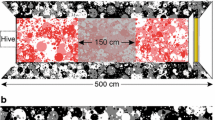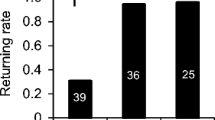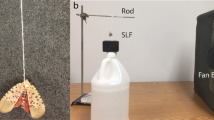Summary
In round-about experiments (rate of success 40%) 80% of the bees began flying after thorax surface temperature had increased toT ts=34.1±1.8°C (warming). The starting temperature difference ΔT ts(=T ts−T a)=6.7±3.06 °C at an ambient temperature of 18.0°C≤T a≤29.6°C (‘normal starts’). The latter decreased to 2.80±0.83°C after 2–5 min and remained constant during 85% of the flight time (42.5±29.2 min) (Fig. 1A). 20% of the bees began flying at ΔT ts=1.6±0.3°C and continued to warm up during the first third of their flight (‘emergency starts’) (Fig. 1 B).
During slowT a changes ΔT ts remained constant. Immediately after a flight stop, temperature increased by 6.2–18.7% during the following 30–60 s (‘out effect’) (Fig. 1C). Dangling the legs resulted in a pronounced temperature loss ofT ts≤1°C (Fig. 1 D).
ΔT ts was negatively correlated withT a at the start (ΔT ts (°C)=88.32e−0.0926 Ta(°C); Fig. 2A), but not correlated toT a during the flight at 20.5°C≤T a≤26.7°C andv=0.72 ms−1 (Fig. 2B). Individual variation was high (Fig. 2C). Flight duration was not correlated toT a (Fig. 2D).
During wind tunnel flights (rate of success 16–38%) ΔT ts reached a steady value after 2–5 min, remained steady during two thirds of the flight, and was not dependent onT a (Fig. 3C). The mean value of ΔT ts was 2.16±0.30°C at 19°C≤T a≤34°C andv=1.8 ms−1.
Heating constants in still air before short walks, longer walks (t≥4 min) and round-about flights were 2.28±0.86 min−1, 3.55±1.33 min−1 and 3.64±0.73 min−1, respectively, but only 1.04±0.26 min−1 under wind tunnel conditions (resting, but exposed to a wind speed of 1.8 m s−1). Cooling constants after flight stop averaged 0.87±0.24 min−1 in still air, 2.8±0.2 min−1 in animals rotated at 0.72 m s−1, and 1.32±0.22 min−1 in animals exposed to a wind speed of 1.8 m s−1. No statistical difference in heating and cooling constants were found in the temperature range 18°C≤T a≤34°C.
A significant positive correlation was found between ΔT ts and\(\dot V_{O_2 }\) in resting bees exposed to a wind speed of 1.8 m s−1 (Fig. 4A-C).
Similar content being viewed by others
References
Bastian J, Esch H (1970) The nervous control of the indirect flight muscles of the honey bee. Z Vergl Physiol 67:307–324
Brandes C (1981) Einfluß von subletalen Mengen E 605 auf neuromotorisch und zentralnervös bedingte Verhaltensänderungen der Honigbiene (Apis mellifica L.). Dissertation, Graz
Casey TM (1976a) Flight energetics of sphinx moth: power input during hovering flight. J Exp Biol 64:529–543
Casey TM (1976b) Flight energetics of sphinx moth: heat production and heat loss inHyles lineata during free flight. J Exp Biol 64:545–560
Casey TM (1980) Flight energetics and heat exchange of gypsy moths in relation to air temperature. J Exp Biol 88:133–145
Casey TM (1981) Insect flight energetics. In: Herreid CF, Fourtner CR (eds) Locomotion and energetics in Arthropods. Plenum Press, New York, 419–452
Church NS (1960) Heat loss and the body temperatures of flying insects. I. Heat loss by evaporation of water from the body. J Exp Biol 37:171–185
Edney EB, Barrass R (1962) The body temperature of the tsetsefly,Glossina morsitans Westwood (Diptera: Muscidae). J Insect Physiol 8:469–481
Esch H (1960) Über die Körpertemperaturen und den Wärmehaushalt vonApis mellifica. Z. Vergl Physiol 43:305–335
Esch H (1964) Über den Zusammenhang zwischen Temperatur, Aktionspotentialen und Thoraxbewegungen bei der Honigbiene. Z Vergl Physiol 48:547–551
Esch H (1976) Body temperature and flight performance of honey bees in a servomechanically controlled wind tunnel. J Comp Physiol 109:265–277
Feller P, Nachtigall W (1989) Flight of the honey bee. II. Inner-and surface thorax temperatures and energetic criteria, correlated to flight parameters. J Comp Physiol B 158:719–727
Heinrich B (1972) Energetics and temperature regulation at foraging in a bumblebee,Bombus terricola Kirby. J Comp Physiol 77:49–64
Heinrich B (1975a) Heat exchange in relation to blood flow between thorax and abdomen in bumblebees. J Exp Biol 64:561–585
Heinrich B (1975b) Thermoregulation in bumblebees. II. Energetics of warm-up and free flight. J Comp Physiol 96:155–166
Heinrich B (1976) Heat exchange in relation to blood flow between thorax and abdomen in bumblebees. J Exp Biol 64:561–585
Heinrich B (1979) Keeping a cool head: Honeybee thermoregulation. Science 205:1269–1271
Heinrich B, Casey T (1978) Heat transfer in dragonflies: flyers and perchers. J Exp Biol 74:17–36
Heran H (1962) Wie beeinflußt eine zusätzliche Last die Fluggeschwindigkeit der Honigbiene? Verh Deutsch Zool Ges Wien 1962:346–354
Hocking B (1953) The intrinsic range and speed of flight of insects. Trans R Entomol Soc Lond 104:223–345
Lefebvre ZA, Hoover RE (1970) Sofubilization, purification and some properties of trehalase from honeybee (Apis mellifera). Arch Biochem Biophys 140:514–518
Lindauer M (1976) Foraging and homing flight of the honeybee: some general problems of orientation. Insect Flight Symp R Entomol Soc Lond 7:199–216
May ML (1979) Insect thermoregulation. Annu Rev Entomol 24:313–349
Nachtigall W, Rothe U, Feller P, Jungmann R (1989) Flight of the honey bee. III. Flight metabolic power, calculated from gas analysis, thermoregulation and fuel consumption. J Comp Physiol B 158:729–737
Nicolson SW, Louw GN (1982) Simultaneous measurement of evaporative water loss, oxygen consumption, and thoracic temperature during flight in a carpenter bee. J Exp Zool 222:287–296
Rothe U, Nachtigall W (1982) Erfahrungen mit einem Bienenflugraum. Spontane Königinnenaufzucht und Lebensdaueranalysen. Apidologica 13:241–246
Rothe U, Nachtigall W (1989) Flight of the honey bee. IV. Respiratory quotients and metabolic rates during sitting, walking and flying. J Comp Physiol B 158:739–749
Shalicki N, Heran H, Crailsheim K (1988) Water budget of the honeybee during rest and flight. In: Nachtigall W (ed) BIONA-report V. Publ Akad Wiss Lit Mainz, Fischer, Stuttgart, pp 103–118
Sotavalta O (1954) On the fuel consumption of the honeybee (Apis mellifica L.) in flight experiments. Ann Zool “Vanamo” 16:1–27
Stabentheiner A, Schinaranzer S (1988) Flight-related thermobiological investigations of honeybees (Apis mellifera carnica). In: Nachtigall W (ed) BIONA-Report V. Publ Akad Wiss Lit Mainz Fischer, Stuttgart, pp 89–102
Weiss-Fogh T (1952) Fat combination and metabolic rate in flying locusts. Phil Trans R Soc London B 237:1–36
Weis-Fogh T (1973) Quick estimates of flight fitness in hovering animals including novel mechanisms for lift production. J Exp Biol 59:169–230
Author information
Authors and Affiliations
Additional information
We dedicate ‘Flight of the honey bee’, parts I-IV to Prof. M. Lindauer on the occasion of his 70th birthday
Rights and permissions
About this article
Cite this article
Jungmann, R., Rothe, U. & Nachtigall, W. Flight of the honey bee. J Comp Physiol B 158, 711–718 (1989). https://doi.org/10.1007/BF00693009
Accepted:
Issue Date:
DOI: https://doi.org/10.1007/BF00693009




